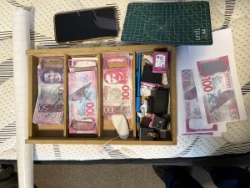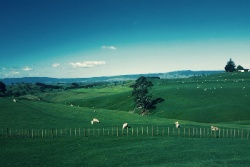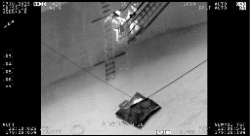John Rutherford returned to his former home towns of Hanmer Springs and Culverden on Anzac Day as the legacy of one its forebears was honoured.
The 103-year-old attended the official celebration to mark the $3.6m restoration of the Soldiers’ Block in Hanmer Springs, which his grandfather Duncan Rutherford was instrumental in establishing.
Earlier in the day he attended the unveiling of a new war memorial in Culverden, with some of his great-grandchildren helping him to plant a tree to mark the occasion.
‘‘We really appreciate what the council has done to recognise our family,’’ Mr Rutherford said.
Duncan Rutherford, a local sheep farmer, owned the Hanmer Lodge Hotel, which he offered to the Government in 1915 as a convalescent home for injured soldiers until the Soldiers’ Block at Queen Mary Hospital was opened in 1916.
He formed a Red Cross committee to fund the makeshift hospital, employing a matron, a cook, domestic staff and provide meals, while the Government provided a doctor, a military officer and medical supplies.
Around 218 soldiers were cared for at the lodge, where local women volunteered as nurses.
Queen Mary Hospital continued to rely on local generosity, with Duncan Rutherford paying for a verandah attached to the dining room, chairs, tables and lounges so soldiers could recuperate in the fresh air.
Christmas dinner and parcels were also provided for the soldiers and hospital staff from the Rutherford family’s Leslie Hills farm.
The Rutherford family has been farming in the Amuri district since 1860, when Mr Rutherford’s great-great-grandfather George Rutherford arrived in the district.
Mr Rutherford lived and farmed between Culverden and Hanmer Springs for 65 years, until moving to Hanmer Springs where he lived for 25 years.
Hurunui Mayor Marie Black said the $3.6m Soldiers’ Block restoration was the culmination of two decades of community advocacy to preserve the site.
‘‘It is tremendous. It demonstrates the value of working in the community.’’
The Soldiers Block was built alongside the hot springs, long valued for healing qualities.
Queen Mary Hospital later became a mental health hospital, and then a drug and alcohol addiction treatment centre under the Taha Māori recovery programme up until 2003.
The Ministry of Health had intentions to sell the site, but the local community rallied round and it was eventually vested in the council in 2010.
The restoration was made possible by funding from Government, the Lotteries Commission, the Rata Foundation and the council’s earthquake fund.
Hanmer Springs firm O’Brien Construction began work restoring the Soldiers’ Block in May 2024.
‘‘It has been an enjoyable job,’’ Mark O’Brien said.
‘‘The building was very sound. It was in very good condition considering its age.’’
To ensure the building survives for another 100 years, O’Brien Construction laid down new foundations, with 64 piles drilled into the ground 900mm deep.
The floors were then restored with the same material as the original floors - Jarrah in the wards and rimu in the hallway.
Hanmer Springs business owner Jason Fletcher was a driving force behind the project.
He said the Soldiers’ Block is now open for community use for events and community functions and there is a community fitness centre onsite.
A wharenui attached to the Soldiers’ Block is also being restored by Ngāti Kūri and will be officially opened later in the year.
Long term the community plans to turn the Soldiers’ Block into an interactive museum, bringing the stories of the soldiers back to life.
The Queen Mary Historic Reserve Trust has been working with Weta Workshop on the design, but will need to raise around $6m.
LDR is local body journalism co-funded by RNZ and NZ On Air.



 Gordon Campbell: On The Costs Of Regulating Cost, And Burkina Faso As A Role Model
Gordon Campbell: On The Costs Of Regulating Cost, And Burkina Faso As A Role Model NZ Police: Cha-Ching - Police Seize Thousands Of Dollars In Fake Bills
NZ Police: Cha-Ching - Police Seize Thousands Of Dollars In Fake Bills Rural Women New Zealand: 100 Years Of Service
Rural Women New Zealand: 100 Years Of Service Serious Fraud Office: SFO Leads Anti-Corruption Taskforce Pilot To Strengthen Public Sector Resilience
Serious Fraud Office: SFO Leads Anti-Corruption Taskforce Pilot To Strengthen Public Sector Resilience Dog Lovers of Monte Cecilia: Locals Challenge Puketāpapa Local Board And Auckland Council’s On-Leash Policy Change For Monte Cecilia Park
Dog Lovers of Monte Cecilia: Locals Challenge Puketāpapa Local Board And Auckland Council’s On-Leash Policy Change For Monte Cecilia Park Maritime New Zealand: Three Rescued In High-Seas Operation After Vessel Abandoned North Of New Zealand
Maritime New Zealand: Three Rescued In High-Seas Operation After Vessel Abandoned North Of New Zealand Health Coalition Aotearoa: Experts Urge Fix As Government Expands Failing Lunch Scheme To Primary Schools
Health Coalition Aotearoa: Experts Urge Fix As Government Expands Failing Lunch Scheme To Primary Schools


